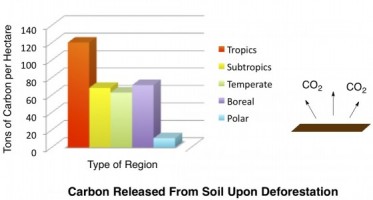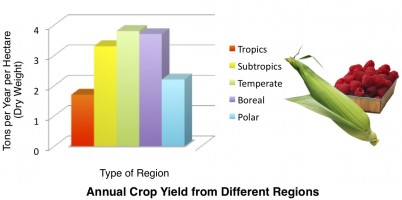It doesn’t take a genius to figure out that replacing rainforests with parking lots would be bad for the environment. But what about clearing the natural flora in order to replant with a different type of vegetation? Intuitively, it makes sense that there are still tradeoffs for clearing acres of trees to make room for agricultural crops, such as wildlife displacement and local climate change. Furthermore, a recent paper in Proc. Natl. Acad. Sci. quantifies these tradeoffs in terms of the carbon cycle.

The Carbon Cycle
The carbon cycle describes the dynamic balance between carbon in the atmospheremostly CO2 and carbon in the biospheremostly organic molecules, like proteins, fats, and plant fibers. When organic molecules in the biosphere get oxidizedreacted with oxygen over time (just like inorganic iron gets oxidized in air to make rust), the molecules are broken down into smaller and smaller pieces until most of the carbon has been converted into CO2, the most oxidized form of carbon. Conversely, plants take in CO2 from the atmosphere and process it back into large organic molecules like cellulose. (See ScienceGeist for an ongoing discussion on atmospheric CO2).

Oxidation of Organic Molecules in Soil
Soil is often rich with partially decomposed plant and animal matter; the dirt covering the earth’s surface represents a vast reservoir of biosphere carbon. When a plot of land is deforested, the organic molecules in the stripped soil become much more exposed to the oxidizing air. Thus, a huge amount of soil carbon is released as CO2 when land is cleared of its original vegetation. On the other hand, the agricultural crops that are planted and harvested represent a new reservoir of carbon – but does the tradeoff in biosphere carbon come close to breaking even?
The answer is no, according to West et al., especially when tropical forest is uprooted. Different types of land release different amounts of carbon into the atmosphere upon deforestation. As shown below, bulldozed tropical regions release the most carbon – over 100 tons of carbon per hectare10,000 m2, or about 2.5 acres.

The amount of carbon matter generated from new crops each year is a much smaller number – only about 1.5 tons per hectare in tropical regions. Therefore, even if crops were composed of 100% carbon, it would take decades to make up for the initial loss of soil carbon. More specifically, the authors point out that even if all the crops are used as biofuel, and thus help save on greenhouse gas emissions by replacing nonrenewable fuels like gasoline, it would still take decades or even centuries for these greenhouse gas savings to make up for the initial release of CO2 upon deforestation.

The authors reach the conclusion that tropical land is the worst choice for agricultural development, since it wastes the most carbon initially and yields the least payback in terms of crops. Clearly, we need agriculture to survive, so the solution is not to stop farming and replant all the land with forests again. Instead, the authors suggest that efforts should focus on improving crop yield on land that has already been converted, rather than in deforesting even more land. They also urge public policy makers to take the global carbon cycle into better account when making agricultural decisions.

